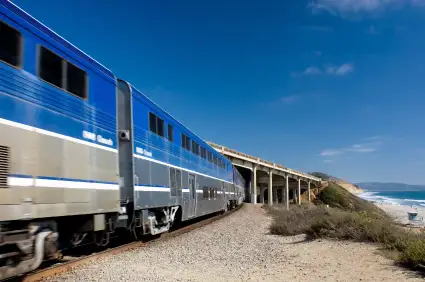
National Train Day, which takes place tomorrow, May 12, includes a variety of events at railroad stations around the country, from big blasts in place in Washington, Philadelphia, Chicago, and Los Angeles to small events at dozens of stations and rail-themed attractions.
But what are we celebrating? The U.S. is woefully behind much of the industrialized world in passenger rail service, and the future does not look bright.
I’m putting these thoughts down near the midpoint of an international trip that will touch, at least briefly, in eight different countries. Seven of the countries have made serious efforts to develop high-speed rail travel (which, in official rail parlance, means trains capable of traveling 156 mph or higher):
- China is by far the world leader, with almost 4,000 miles of genuine high-speed lines and almost that many more under construction or planned.
- Korea has a high-speed main line linking its two most important cities, Seoul and Busan.
- Turkey has opened about half of its Istanbul-to-Ankara main line, as well as some other lines.
- Switzerland is concentrating on extra-long tunnels rather than more conventional high-speed lines, with the Lotschberg base tunnel already open and the record-breaking Gotthard base tunnel well under way.
- France currently operates more than 1,350 miles of high-speed lines, with more under construction.
- Italy’s 660-mile line from Turin to Naples was completed last year, with branches yet to come.
- Poland has an almost-high-speed line from Warsaw to Krakow.
- The lone exception? Dubai, where officials are at least talking about high-speed rail links to neighboring Gulf states.
By contrast, according to a generous estimate from the the International Union of Railways (UIC), the U.S. has 225 miles of high-speed rail in the Northeast Corridor.
Why is the U.S. lagging? As far as I can tell, our national position demands some direct return on the huge investments high-speed rail requires, and no high-speed system can begin to cover both operating costs and debt service out of fares. Countries that have built high-speed rail systems have done so in part to avoid having to build more highways and airports. Environmental benefits are also a big factor. Although those benefits are real—and clever consultants can ascribe really big numbers to them—they do not seem to satisfy our budget-conscious federal government or most state governments. An authoritarian central government is more able to build a high-speed rail network than is a fractious and divided democracy.
As a partial gesture toward privatization, several countries have adopted a system in which the government builds the tracks, then leases out operating rights to private companies that are expected to run without subsidy. Several proponents have called for this approach in the U.S. The jury is still out on how well this works, but some countries are giving it a try.
Real high-speed rail requires a separate, dedicated roadbed, which also generally requires lots of tunnels and bridges—all extremely expensive. For now, the main U.S. effort along those lines is in California, where officials are at least trying to develop a genuine high-speed system linking San Francisco and Sacramento with Los Angeles and San Diego. Although the state passed a big bond issue to get the system started, it still has a long way to go for the full funding.
By contrast, several Midwestern states are funding, with government support, improvements in conventional rail lines enough to support higher speed rail, including much on track shared with freight operations. The target here is maybe 110 or 120 mph, tops—not true high speed, but double what Amtrak now averages.
Meanwhile, poor old Amtrak drags along, begging every year for enough money to keep going, operating infrequent, slow, but pleasant long-haul trains.
The U.S. is doing a bit better with commuter rail. Boston, Chicago, New York, and Philadelphia enjoy robust commuter rail systems—inherited from the golden age of rail—and other big cities operate at least several lines. Heavy-rail metro systems operate in more than a dozen U.S. cities, and light rail is staging a nationwide renaissance. All these systems, however, are struggling financially, and many face cutbacks due to decreasing local funding.
If you want a really upbeat train story, you have to look at freight. The big U.S. railroads are earning record profits and they’re upgrading tracks and equipment to handle the healthy demand. If that satisfies your train itch, then celebrate. It’s a great story. But if you’re interested in dynamic passenger railroading, you have to hop a plane to Asia or Europe.
You Might Also Like:
We hand-pick everything we recommend and select items through testing and reviews. Some products are sent to us free of charge with no incentive to offer a favorable review. We offer our unbiased opinions and do not accept compensation to review products. All items are in stock and prices are accurate at the time of publication. If you buy something through our links, we may earn a commission.
Related
Top Fares From
Today's Top Travel Deals
Brought to you by ShermansTravel
Porto to Lisbon: 7-Nt, Small-Group Portugal...
Indus Travels
 vacation
$1899+
vacation
$1899+
Greenland: Luxe, All-Incl. 11-Nt Exploration Small-Ship...
Swan Hellenic



Ohio: Daily Car Rentals from Cincinnati
85OFF.com





